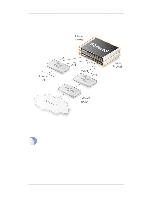D-Link DFL-260 Product Manual - Page 493
Upgrading an HA Cluster
 |
UPC - 790069296802
View all D-Link DFL-260 manuals
Add to My Manuals
Save this manual to your list of manuals |
Page 493 highlights
11.5. Upgrading an HA Cluster Chapter 11. High Availability 11.5. Upgrading an HA Cluster The NetDefendOS software versions running on the master and slave in an HA cluster should be the same. When a new NetDefendOS version becomes available and is to be installed on both units, the upgrade is done one unit at a time. The central principal in the upgrade process for a cluster is that upgrading the inactive unit will not effect the operation of the cluster and only momentarily make the inactive unit unavailable. The overall sequence of steps to follow is: i. Identify which unit is inactive and upgrade that first. ii. When the inactive unit is once again synchronized with the active unit, cause a failover to occur so that the inactive becomes the active unit. iii. Now upgrade the inactive unit. Both units will then resynchronize and have the new NetDefendOS version. These three steps will now be broken down into a more detailed description: A. Establish which is the inactive unit in the cluster The currently inactive unit will be upgraded first so it is necessary to identify this. To do this, connect with a CLI console to one of the cluster units and issue the ha command. The typical output if the unit is active is shown below. gw-world:/> ha This device is a HA SLAVE This device is currently ACTIVE (will forward traffic) This device has been active: 430697 sec HA cluster peer is ALIVE This unit (the slave) is the currently active unit, so the other one (the master) is the inactive unit. B. Upgrade the inactive unit Once the inactive unit is identified, upgrade this unit with the new NetDefendOS version. This is done exactly as though the unit were not in a cluster. For example, the Web Interface can be used to do the upgrade. Important: Make sure the inactive unit is ALIVE Before going to the next step make sure the inactive unit is fully operational and synchronized with the active unit after the software upgrade completes. To do this, issue the CLI ha command on the inactive unit. The output from the command should indicate that the status is ALIVE. gw-world:/> ha This device is a HA SLAVE This device is currently INACTIVE (won't forward traffic) This device has been inactive: 2 sec HA cluster peer is ALIVE C. Cause a failover to occur Now, connect to the active unit (which is still running the old NetDefendOS version) with a CLI 493















